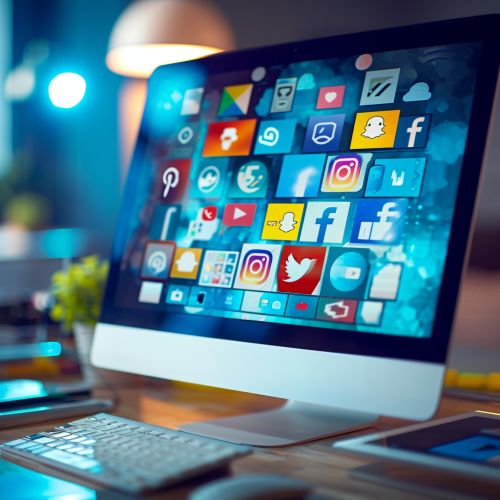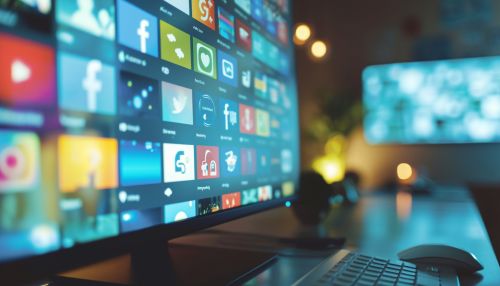New media
Introduction
New media refers to digital, interactive, and networked information and communication technologies that have emerged since the latter part of the 20th century. These technologies include the internet, social media, digital games, multimedia, and mobile devices. New media is characterized by its ability to manipulate, network, and interconnect vast amounts of information in a variety of formats, including text, images, sound, and video. It is distinguished from traditional media, such as print, radio, and television, by its digital nature and its capacity for interactivity.
Characteristics of New Media
New media is defined by several key characteristics, including digitalization, interactivity, hypertextuality, dispersal, and virtuality.
Digitalization
New media is inherently digital, meaning it uses binary code to encode information. This allows for the manipulation, storage, retrieval, and transmission of vast amounts of data with unprecedented speed and accuracy. Digitalization also enables the convergence of different types of media into a single platform, such as the internet, where text, images, sound, and video can be integrated and interacted with in a variety of ways.
Interactivity
Interactivity is a defining feature of new media. Unlike traditional media, which is largely one-way and passive, new media allows for two-way communication and active participation. Users can create, modify, and share content, engage in social networking, play interactive games, participate in virtual communities, and perform a host of other activities. This interactivity is facilitated by the use of interfaces, which mediate between the user and the digital environment.
Hypertextuality
New media is characterized by its hypertextual nature. Hypertext is a system of linked documents or pieces of information, which allows for non-linear navigation and the creation of multiple pathways through a body of information. This hypertextuality is exemplified by the World Wide Web, where documents are interconnected through hyperlinks, allowing users to navigate from one piece of information to another in a non-sequential manner.
Dispersal
New media is dispersed and decentralized. It operates in a networked environment, where information is distributed across multiple nodes and can be accessed from anywhere at any time. This dispersal of information challenges traditional notions of space and time, as well as authority and control over information.
Virtuality
New media is virtual, meaning it exists in digital form rather than physical form. This virtuality allows for the creation of virtual worlds, avatars, and other digital entities, as well as the simulation of real-world environments and experiences. Virtuality also enables the transcoding of information, where data can be converted from one format to another, such as from text to image or sound to video.


Impact of New Media
The emergence of new media has had a profound impact on society, culture, and the economy. It has transformed the way we communicate, learn, work, play, and interact with the world around us.
Communication
New media has revolutionized communication, making it more interactive, participatory, and social. It has given rise to social media platforms, such as Facebook, Twitter, and Instagram, which allow users to create and share content, connect with others, and participate in online communities. It has also enabled new forms of communication, such as instant messaging, video conferencing, and blogging.
Education
New media has transformed education, providing new tools and platforms for learning and teaching. It has enabled e-learning, online courses, and virtual classrooms, making education more accessible and flexible. It has also facilitated collaborative learning, interactive simulations, and multimedia presentations, enhancing the learning experience.
Work
New media has reshaped the workplace, enabling remote work, virtual teams, and digital collaboration. It has also facilitated the automation of tasks, the tracking of performance, and the management of information. Furthermore, it has given rise to new industries and professions, such as digital marketing, web design, and game development.
Entertainment
New media has revolutionized entertainment, giving rise to digital games, streaming services, and virtual reality experiences. It has also transformed traditional forms of entertainment, such as music, film, and television, through digitalization and interactivity.
Society and Culture
New media has had a profound impact on society and culture. It has influenced the way we perceive and interact with the world, shaping our identities, relationships, and communities. It has also transformed the public sphere, enabling new forms of civic participation, political activism, and social change.
Challenges and Criticisms
While new media offers many opportunities, it also presents several challenges and has been subject to various criticisms.
Digital Divide
The digital divide refers to the gap between those who have access to new media technologies and those who do not. This divide is often based on socioeconomic factors, such as income, education, and location. It can lead to inequalities in information access, communication, and participation.
Privacy and Surveillance
New media raises concerns about privacy and surveillance. The collection, storage, and analysis of personal data by companies and governments can lead to invasions of privacy and violations of civil liberties. Furthermore, the use of surveillance technologies, such as CCTV cameras and tracking cookies, can result in a culture of surveillance.
Misinformation and Fake News
New media can facilitate the spread of misinformation and fake news. The speed and reach of digital communication, combined with the lack of regulation and oversight, can lead to the rapid dissemination of false or misleading information. This can have serious consequences for public opinion, political discourse, and social cohesion.
Cyberbullying and Online Harassment
New media can enable cyberbullying and online harassment. The anonymity and distance afforded by digital communication can lead to aggressive and harmful behavior. This can have serious psychological and emotional impacts, particularly for vulnerable individuals and groups.
Conclusion
New media is a complex and dynamic phenomenon that has transformed the way we live, learn, work, and interact. It offers many opportunities, from enhanced communication and learning to new forms of entertainment and social participation. However, it also presents several challenges, from the digital divide and privacy concerns to misinformation and online harassment. As new media continues to evolve, it is crucial to understand its impacts and implications, and to navigate its opportunities and challenges with care and critical awareness.
